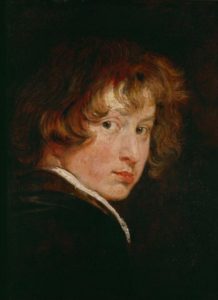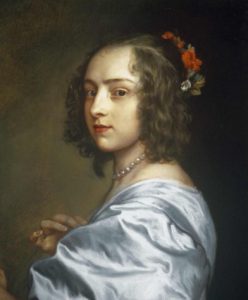There are no true child prodigies in the visual arts. No 4-year-old has ever drawn with the facility that the young Mozart demonstrated in musical composition or that other prodigies have demonstrated in math or chess. Still, there are those who, trained at art from an early age, show uncanny skill. So it was with the dazzling Anthony Van Dyck (1599-1641), who was apprenticed to a Flemish master at age 10 and was chief assistant to Peter Paul Rubens by his mid-teens.

In a painting he did at 14, the baby-faced artist peers over his shoulder through tousled red locks, his large eyes taking in everything. He might have been a little shy, but he wasn’t modest. He knew just how special he was.
You can see for yourself at the Frick Collection, where this is among a hundred or so paintings and drawings in a show devoted to Van Dyck’s portraits. It’s the kind of loan exhibit usually seen at bigger museums, but the Frick seems the perfect fit for it – founder Henry Clay Frick loved him so much he bought eight of his paintings.
Van Dyck cast off all modesty in the self-portrait he did at age 21. By then, he was well on his way to becoming the most sought after portrait painter in Europe. A contemporary described him as “by nature grand and eager to become famous.” With the elegant black cape and flamboyantly posed hands, the picture could pass for a magician’s self-promotion.

After six years in Italy, Van Dyck was invited in 1632 to be court painter to the King of England, Charles I. He had less than a decade to live, but it was in this period that he left his mark on history. The show’s masterpiece is his double portrait of the king and his French wife, Henrietta Maria (for whom the colony of Maryland was named). Rarely do portraits like this display such tender feeling. The two are bathed in a poignant twilight atmosphere. The king looks smitten, unable to take his eyes off the queen, while she, in looking out at us, assumes the more official role.
Men had the more elaborate coiffures in those days. The more aristocratic they were, the more they looked like spaniels. Many also sported a chin-beard and moustache, including the artist, such that the style, to this day, is called “a Van Dyck.”
There’s a touch of irony, perhaps unintended, in the exhibit’s title, “Van Dyck: The Anatomy of Portraiture.” It suggests that viewers may learn how these paintings developed through lots of preparatory studies and oil sketches. The show has plenty of beautiful drawings, but for the oil portraits Van Dyck typically did only one rough sketch of his subjects. In these, he mapped out the pose and the sitter’s clothes, but left only a slight, ghostly suggestion of a face. He preferred, apparently, to work out the sitter’s likeness directly on the canvas. Sitters then sent their clothes over to the studio and these parts of the painting were completed by assistants, with a final going-over by Van Dyck.
Evidence for this method can be seen in the portrait of an unidentified woman whose face is the only completely finished part of the painting. It is believed she died in childbirth and the order for the portrait was canceled.

Margaret Lemon
Novelist Marcel Proust wrote an ode to Van Dyck in which he praised his depiction of “royal children, already magnificent and grave.” It’s a perfect description of the double portrait of 13-year old Prince William of Orange and 9-year-old Mary, daughter of King Charles and Henrietta Maria. They look like two children playing dress-up – except the painting is an official marriage portrait.
Van Dyck married late – only two years before his death – but before that he had a mistress, Margaret Lemon, with whom he shared his house and had a daughter. The Frick exhibit puts the two women’s portraits side-by-side. Both are young, beautiful women. The wife, Mary Ruthven, gets the larger canvas, but she is set deeper into the picture, in a more elegant, formal pose. The mistress is closer to the viewer, more accessible, her shoulder right up against the picture plane.
Van Dyck owes some of his fame to the circulation of his portrait prints. The best known of these was a set called the “Iconographie,” which included half-length portraits of various luminaries, including fellow Flemish artists, scholars, statesmen and aristocratic ladies. The Frick devotes a small gallery to this series. Some were etched by van Dyck, himself and are works of incredible precision and density for such small images. The same is true of the incisive gray-scale oil sketches he did to assist the engravers.
No matter the medium, he handled it with mastery and poetry. He had a lasting influence on English portraiture. Many prodigies fail to live up to their promise, but Van Dyck was a teenage wunderkind whose star never faded.

